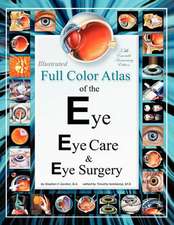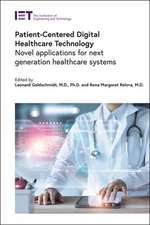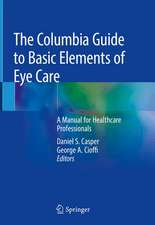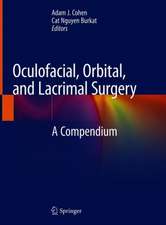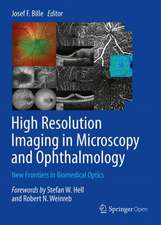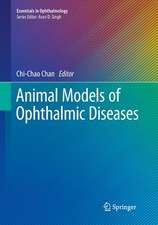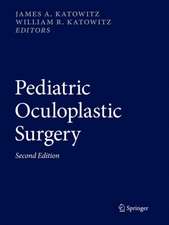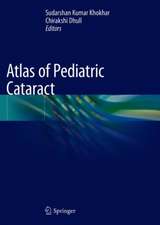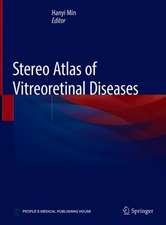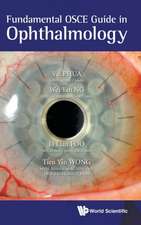Digital Eye Care and Teleophthalmology: A Practical Guide to Applications
Editat de Kanagasingam Yogesan, Leonard Goldschmidt, Jorge Cuadros, Giselle Ricuren Limba Engleză Hardback – 20 iun 2023
Digital Eye Care and Teleophthalmology: A Practical Guide to Applications examines digital eye care to provide state of art ophthalmic services. It is an essential resource for professionals involved in eye care seeking to develop or improve their digital applications in daily practice.
Preț: 884.49 lei
Preț vechi: 931.05 lei
-5% Nou
Puncte Express: 1327
Preț estimativ în valută:
169.25€ • 176.36$ • 140.14£
169.25€ • 176.36$ • 140.14£
Carte tipărită la comandă
Livrare economică 31 martie-05 aprilie
Preluare comenzi: 021 569.72.76
Specificații
ISBN-13: 9783031240515
ISBN-10: 3031240510
Pagini: 534
Ilustrații: XII, 534 p. 255 illus., 230 illus. in color.
Dimensiuni: 178 x 254 mm
Greutate: 1.11 kg
Ediția:2023
Editura: Springer International Publishing
Colecția Springer
Locul publicării:Cham, Switzerland
ISBN-10: 3031240510
Pagini: 534
Ilustrații: XII, 534 p. 255 illus., 230 illus. in color.
Dimensiuni: 178 x 254 mm
Greutate: 1.11 kg
Ediția:2023
Editura: Springer International Publishing
Colecția Springer
Locul publicării:Cham, Switzerland
Cuprins
1. Tele-Ophthalmology and COVID.- 2. A Practical Guide to Telehealth in Ophthalmology.- 3. Smartphone Technology for Teleophthalmology.- 4. Ethical Recommendations for Online Medical Consultation and Teleophthalmology.- 5. The Use of Telehealth in Optometry: Present and Future Clinical Applications.- 6. Low Vision and Ocular Rehabilitation Telehealth.- 7. Best Practices: Telemedicine-Diabetic Retinopathy.- 8. Teleretinal Diabetic Retinopathy Screening In Primary Care Settings - Considerations For Safety Net Organizations.- 9. Image processing in Retinal Imaging.- 10. OCT imaging and applications in the retina.- 11. Ultrawide field imaging.- 12. Digital Glaucoma.
Notă biografică
Professor Yogesan is a Chair of Digital Health and Telemedicine at the School of Medicine, University of Notre Dame, Australia. He is also Visiting Scholar at the Harvard University. In addition, he is Senior Advisor to Medivitals (Aus), SPEQS (Aus) and Lifeguard Health Networks (USA). He has obtained many awards including WA Australian of the Year Finalist, Achiever of the Year in 2018, WAITTA INCITE Awards 2017-2018, one of the Inventors of the Year Awards in 2006 and 2008 (for EyeScan device and i-Test). He has published over 85 peer-reviewed research papers and books in the field (including the first textbook in Tele-ophthalmology). He has a patent portfolio of over 35 patents including ophthalmic diagnostic devices, machine learning algorithms for early detection of eye diseases and systemic diseases, and telemedicine systems. He has strong record in translation of research findings into clinical practice.
Dr. Goldschmidt wasan early innovator in telemedicine and medical informatics, exploring use of the technologies in patient education, Cardiology, Pathology, and in patients with spinal cord injury. He is an ophthalmologist at the Department of Veterans Affairs (VA) Health Care System in Palo Alto, California and was formerly director of medical informatics at that facility. In addition, he is also Clinical Associate Professor in Ophthalmology at the Stanford University School of Medicine and participates in teaching the next generation of doctors. Dr. Goldschmidt was co-director for many years of one of the earliest large- scale diabetic teleretinal screening programs at the Department of Veterans affairs, an organization serving approximately nine million patients. VA’s electronic patient record system is among the largest in the world, and Dr. Goldschmidt was instrumental in leading efforts to enhance the capabilities of its imaging archive, which works seamlessly with the individual medical record. Currently, he serves as a subject matter expert for the organization, helping to continually improve VA's telemedicine capabilities. He participates widely as an invited speaker, sharing the lessons from a health care system that serves patients from Hawaii to the east coast of the United States.
Professor Cuadros is Director of Informatics Research in the Department of Optometry and Vision Science at the University of California, Berkeley and he is a pioneer in introducing telemedicine based eye screening programs in the USA and internationally. He is CEO of EyePACS (Santa Cruz, CA, USA), a telemedicine service, providing screening to more than one million patients. He has conducted clinical trials on several innovative technologies, such as automated retinal image reading, laser imaging devices, and primary care programs. His work is focused on expanding access to eye care in underserved communities.
Giselle Ricur is a Latin-American pioneer in teleophthalmology. Founder of the American Telemedicine Association’s Latin American and Caribbean chapter in 2004 (ATALACC). She has spearheaded telemedicine program developments, training, and advocating for eHealth policy adoption since the early 2000s’. Currently, she is the Executive Director of Virtual Care at Bascom Palmer Eye Institute at the University of Miami. Her background includes being an Accredited Specialist in Ophthalmology in Argentina, an MBA in Strategic Direction at EUNCET Polytechnic University of Catalonia, and a M.Sc. in Healthcare Management at the Swiss Business School (SBS). Dr. Ricur has held several faculty positions in Argentina and has served as an international consultant for PAHO/WHO, CEPAL/UN, ICO, CAO, and the PAAO. Her publications, lectures, and classes throughout the LATAM region focus mainly on the patient-physician virtual relationship as well as the use of unified video communication technologies applied to the remote assessment of the eyes in real-time.
Dr. Goldschmidt wasan early innovator in telemedicine and medical informatics, exploring use of the technologies in patient education, Cardiology, Pathology, and in patients with spinal cord injury. He is an ophthalmologist at the Department of Veterans Affairs (VA) Health Care System in Palo Alto, California and was formerly director of medical informatics at that facility. In addition, he is also Clinical Associate Professor in Ophthalmology at the Stanford University School of Medicine and participates in teaching the next generation of doctors. Dr. Goldschmidt was co-director for many years of one of the earliest large- scale diabetic teleretinal screening programs at the Department of Veterans affairs, an organization serving approximately nine million patients. VA’s electronic patient record system is among the largest in the world, and Dr. Goldschmidt was instrumental in leading efforts to enhance the capabilities of its imaging archive, which works seamlessly with the individual medical record. Currently, he serves as a subject matter expert for the organization, helping to continually improve VA's telemedicine capabilities. He participates widely as an invited speaker, sharing the lessons from a health care system that serves patients from Hawaii to the east coast of the United States.
Professor Cuadros is Director of Informatics Research in the Department of Optometry and Vision Science at the University of California, Berkeley and he is a pioneer in introducing telemedicine based eye screening programs in the USA and internationally. He is CEO of EyePACS (Santa Cruz, CA, USA), a telemedicine service, providing screening to more than one million patients. He has conducted clinical trials on several innovative technologies, such as automated retinal image reading, laser imaging devices, and primary care programs. His work is focused on expanding access to eye care in underserved communities.
Giselle Ricur is a Latin-American pioneer in teleophthalmology. Founder of the American Telemedicine Association’s Latin American and Caribbean chapter in 2004 (ATALACC). She has spearheaded telemedicine program developments, training, and advocating for eHealth policy adoption since the early 2000s’. Currently, she is the Executive Director of Virtual Care at Bascom Palmer Eye Institute at the University of Miami. Her background includes being an Accredited Specialist in Ophthalmology in Argentina, an MBA in Strategic Direction at EUNCET Polytechnic University of Catalonia, and a M.Sc. in Healthcare Management at the Swiss Business School (SBS). Dr. Ricur has held several faculty positions in Argentina and has served as an international consultant for PAHO/WHO, CEPAL/UN, ICO, CAO, and the PAAO. Her publications, lectures, and classes throughout the LATAM region focus mainly on the patient-physician virtual relationship as well as the use of unified video communication technologies applied to the remote assessment of the eyes in real-time.
Textul de pe ultima copertă
This book describes digital ophthalmology and telemedicine applications for both front of the eye and retina. It includes technical issues, digital imaging, what clinical parameters to use, which technologies are suitable, and collective experiences of practitioners in different parts of the world practicing a wide range of digital eye care delivery. The main purpose of this book is to provide adequate information to clinicians and other health professionals who are involved in eye care delivery to assess how digital health in ophthalmology might be applied to their working practice, how digital screenings are performed, and to learn about virtual image reading. Many of the chapters are also helpful to health service managers, imaging specialists, and information technology staff.
Digital Eye Care and Teleophthalmology: A Practical Guide to Applications examines digital eye care to provide state of art ophthalmic services. It is an essential resource for professionals involved in eye care seeking to develop or improve their digital applications in daily practice.
Digital Eye Care and Teleophthalmology: A Practical Guide to Applications examines digital eye care to provide state of art ophthalmic services. It is an essential resource for professionals involved in eye care seeking to develop or improve their digital applications in daily practice.
Caracteristici
Examines machine learning and artificial intelligence in ophthalmology Discusses remote delivery of eye care for mass populations Provides a global perspective on tele-ophthalmology

